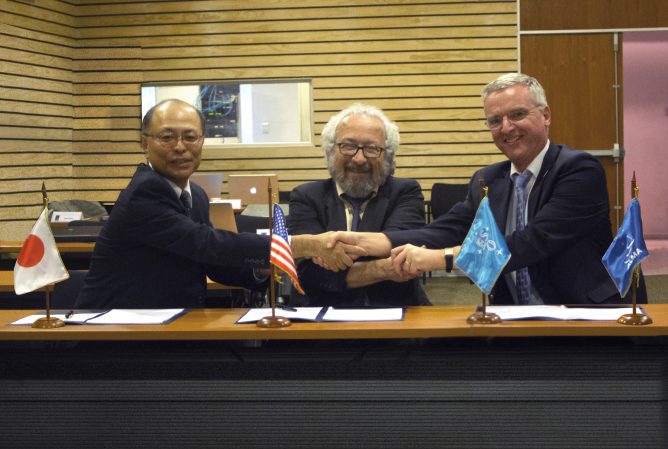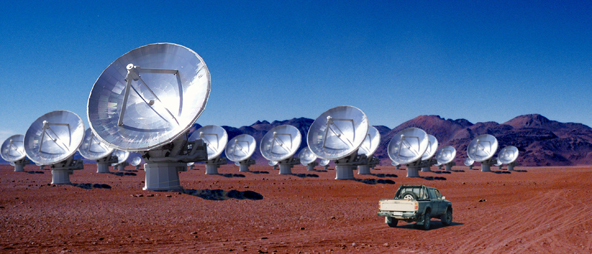On December 15, 2015, the National Institutes of Natural Sciences of Japan (NINS), the European Southern Observatory (ESO), and the National Science Foundation (NSF) signed an agreement concerning the operations of ALMA. The new agreement signed in Tokyo provides the framework for the long-lasting operations of ALMA over the next 20 years.
“As NINS, we have responsibility to fulfill our commitment to the operations of ALMA as a party of this agreement.” told Katsuhiko Sato, the president of NINS, in his speech in the signing ceremony. “We hope our contributions could lead to significant scientific results with ALMA. And, our contributions will be beneficial to global advances in understanding the physics of the Universe as stated in the agreement.”
The first resolution for ALMA was concluded at the ALMA Coordination Committee meeting held in Tokyo in 2001. This was the formal start of the international collaboration project between Japan, US, and Europe. The construction budgets were approved in US and Europe in 2001 and 2002 respectively. While the budget in Japan was yet to be approved at that time, NSF and ESO signed a bilateral agreement in 2003 and started construction of “the Atacama Large Millimeter Array (ALMA)”. Japan finally secured the budget in 2004 and joined the project by signing an agreement for the construction of the enhanced ALMA. Japan brought an enhanced capability of submillimeter observations and “Atacama Large Millimeter/submillimeter Array” was realized.
“Big telescopes demand big partnerships,” said France A. Cordova, the director of NSF in her video message for the ceremony. “Today’s new trilateral agreement is the evidence of the commitment. We mark a point when ALMA’s future is made brighter, because our three organizations zeal to learn more about the universe where we all live.”
“The ALMA conference which took place in Tokyo last year demonstrated that the dream of a truly transformational facility for astronomy has become a reality.” told Tim de Zeeuw, the Director General of ESO. “I am certain that the power and efficiency of the facility will continue to increase in the years to come. It is a testimony to the visionary and motivated individuals who laid the groundwork more than three decades ago, and turned it onto a reality.”
The construction of ALMA and initial observations have been carried out based on the agreement signed in 2004. With an inauguration ceremony held in 2013, ALMA formally became a fully-fledged observatory. A new agreement focusing on science operations have been prepared since then, and signed this time by Sato, de Zeeuw and F. Fleming Crim, the assistant director of NSF on behalf of France A. Córdova.
After the signing ceremony, the delegates from ESO and NSF visited the NAOJ headquarters. Under the guidance of Masa Hayashi, the Director General of NAOJ, they enjoyed the 4D2U theater, NAOJ Observatory History Museum, the gravitational wave detector TAMA300, and the NAOJ Advanced Technology Center.
-

- The ALMA Trilateral Agreement was signed by Tim de Zeeuw, the Director General of ESO, Katsuhiko Sato, the President of NINS, and F. Fleming Crim, the Assistant Director of NSF on behalf of France A. Córdova, the Director of NSF.
Credit: ALMA (ESO/NAOJ/NRAO)
-

- Katsuhiko Sato, the President of NINS.
Credit: ALMA (ESO/NAOJ/NRAO)
-

- Tim de Zeeuw, the Director General of ESO.
Credit: ALMA (ESO/NAOJ/NRAO)
Participants of the ALMA Trilateral Agreement Signing Ceremony.
Credit: ALMA (ESO/NAOJ/NRAO)










